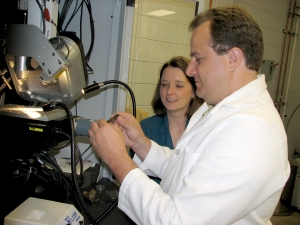May 29 2008
Auburn University professors are researching new ways to store and recycle nuclear waste as the federal government seeks to boost nuclear power production.
 Auburn University researchers Anne Gorden and Tom Albrecht-Schmitt use a powder X-ray difractometer to analyze a new material. They are working with the U.S. Department of Energy to develop new solid materials for radiological storage applications.
Auburn University researchers Anne Gorden and Tom Albrecht-Schmitt use a powder X-ray difractometer to analyze a new material. They are working with the U.S. Department of Energy to develop new solid materials for radiological storage applications.
The U.S. Department of Energy is funding AU’s Center for Actinide Science to find chemical compounds that would combine with radioactive elements, allowing them to be safely stored without risk of radiation leakage. The nuclear material would be recycled for future use in energy production.
“Twenty percent of the electricity generated in the United States is from nuclear reactors,” said Tom Albrecht-Schmitt, center director. “The U.S. currently uses a one-time process and then must store the highly radioactive waste. Many other countries recycle the fuel rod components.”
Nuclear power plants use uranium fuel rods to heat water, which produces steam and drives a turbine that generates electricity. Spent fuel rods are highly radioactive and must be stored safely in water and later in metal casings for centuries until the radiation level decreases.
Auburn is one of five universities in the country with the capability and expertise to conduct research into nuclear waste storage for recycling, said Albrecht-Schmitt, who added that the Department of Energy is considering building a nuclear fuel recycling facility, perhaps at Savannah River National Laboratory in South Carolina. The Department of Energy will evaluate and possibly use technology developed from the universities’ actinide science research, which is the study of chemically similar radioactive elements.
“At Auburn, we are developing many different new solids for radiological storage applications,” Albrecht-Schmitt said. “We want to make materials that will sequester radioactive elements and that will be resistant to radiation damage and to environmental factors such as air and water.”
The key, he says, is to carefully select, and in some cases design, an appropriate crystalline lattice that tightly binds radioactive elements with non-radioactive particles. A crystalline lattice is the three-dimensional framework of how an atom attaches to another atom. Those used by Albrecht-Schmitt make it difficult for the radioactive elements to break away even under intense radiation or by chemical means.
This method would be for “short-term” storage of radioactive waste that rapidly decays over the course of a few centuries. Another goal is to develop materials to store the waste for the long term, possibly thousands of years, which he says will be challenging with current technology.
“The country’s research into nuclear waste storage for recycling is in the very early stages,” Albrecht-Schmitt said. “It will take 10 to 20 years to apply new research that is being developed now, but we have to make the discoveries today.”
His AU colleagues are also researching new technology to aid the nuclear power industry. Assistant Professor Anne Gorden of the Department of Chemistry is working on making new organic ligands, or molecules that selectively recognize and bind metals, for trapping and removing radioactive elements from nuclear waste.
“A nuclear plant’s cooling water is now stored as waste,” Gorden said. “If we can extract the radioactive elements, then we could drastically reduce the amount of waste water that needs to be stored.”
Gorden’s research uses nitrogen- and oxygen-containing compounds as the basis to extract the radioactive elements, which she says would allow the radioactive particles to be incinerated with reduced impact on the environment. Current technology for extraction is based upon using phosphorus or sulfur, both of which cannot be incinerated because they would contaminate the environment.
She also is working on a color-coded sensor that would detect levels of uranium or plutonium at contaminated sites. She says the sensor would be advantageous over the Geiger counter, which does not detect the primary radiation from plutonium.
AU’s Center for Actinide Science, established one year ago, has six faculty from the College of Sciences and Mathematics – including the departments of physics, geology and chemistry – conducting research. The U.S. Department of Energy funds the center and has awarded $1.5 million to Albrecht-Schmitt’s research projects during the past eight years, which benefits research and student instruction.
“Auburn students receive training unlike at any other university,” said Albrecht-Schmitt, who has mentored nine Ph.D. graduates. “Our students have good opportunities to get jobs at national labs because of the unique situation at Auburn.”